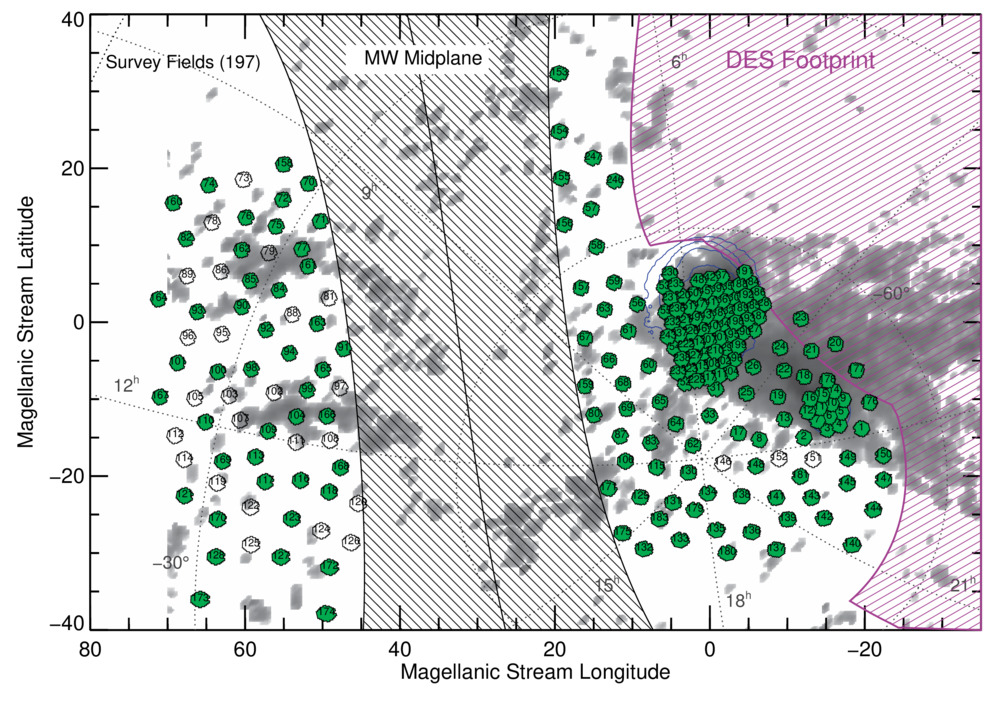
SMASH
A DECam survey with the goal of identifying broadly distributed, low surface brightness stellar populations associated with the stellar halos and tidal debris of the MCs.

The Survey of the Magellanic Stellar History (SMASH) used the Dark Energy Camera (DECam) to map 480 square degrees of sky to depths of ugriz~24th mag with the goal of identifying broadly distributed, low surface brightness stellar populations associated with the stellar halos and tidal debris of the Magellanic Clouds. It contains measurements of approximately 360 million objects distributed in discrete fields spanning an area of about 2400 square degrees. The first data release (DR1) contained ~100 million objects from 61 observed fields, while the second data release contains all 360 million objects in 197 fields. Browse these pages to learn more about SMASH and to access the data. The SMASH overview paper (Nidever et al. 2017) describes the survey in detail, including its goals, survey strategy, reduction, and calibration.
The smash_dr2.object table has been crossmatched against some reference datasets (except SDSS due to 0 matches) within a 1.5 arcsec radius, nearest neighbor only. These tables will appear with x1p5 in their name in our table browser.
Example: smash_dr2.x1p5__object__gaia_dr3__gaia_source.
| SMASH at a Glance | |
|---|---|
| Area covered | 480 deg2 spanning ~2400 deg2 |
| Bands | ugriz |
| Depth (5σ, ugriz) | 23.9, 24.8, 24.5, 24.2, 23.5 mag |
| Seeing (ugriz) | 1.22, 1.13, 1.01, 0.95, 0.90 arcsec |
| Number of fields | 197 |
| Number of DECam exposures | 5,982 |
| Number of objects | 360,201,921 |
| Number of measurements | 4,155,114,664 |
| Photometric precision | ~1% in u and 0.5-0.7% in griz |
| Photometric calibraton accuracy | ~1.3% in all bands |
| Astrometric accuracy | ~20 mas |
Using old main sequence stars as tracers, SMASH is revealing the relics of the formation and past interactions of the Clouds down to surface brightnesses equivalent to Σg=35 mags arcsec2. The main project goals are:
The figure below shows the 197 SMASH fields which are being publicly released in the second SMASH data release (DR2) which contains ~4 billion measurements of ~360 million objects in fields sampling the ~2400 deg2 region of the SMASH survey (green hexagons in the figure below). The main data access is through the Astro Data Lab. Access and exploration tools include a custom Data Discovery tool, database access to the catalog (via direct query or TAP service), an image cutout service, and a Jupyter notebook server with example notebooks for exploratory analysis.
Database: There are seven SMASH DR2 tables in the database: field, exposure, chip, source, object,
deep and xmatch. The “field” table
includes summary information for each field. Click on smash_dr2 on the left-side of the Data Lab
Query Interface to browse the schema and columns.

DR2 contains the first release of SMASH data from the central regions of “main bodies” of the Large and Small Magellanic Clouds. There are 1177 exposures in 68 contiguous SMASH fields of the LMC covering 15 deg x 18.5 deg. 25 fields have deep exposure while 43 only have shallow (~60 sec) exposures. There are 412 exposures in 13 deep contiguous SMASH fields of the SMC covering 8.5 deg x 7.4 deg. Three color mosaics are shown below (click on them for a zoomable view). They were presented as a poster at the ESO workshop A synoptic view of the Magellanic Clouds: VMC, Gaia and beyond in Garching, Germany on September 9-13, 2019. <p></p>
The SMASH data reduction of the DECam data makes use of three separate software packages: (1) the Community Pipeline for instrument signature removal, (2) PHOTRED for PSF photometry, and (3) SMASHRED, custom software written for PHOTRED pre- and post-processing of the SMASH data.
Instrument Signature Removal: The NOIRLab DECam Community Pipeline (Valdes et al. 2014) was jointly developed by the Dark Energy Survey Data Management (DESDM) team and NOIRLab to produce reduced images for the community. The CP performs bias and crosstalk correction, masking of bad pixels and other artifacts, linearity correction, flat field and illumination calibration, fringe pattern subtraction, astrometric and photometric calibration, sky pattern subtraction, remapping and coaddition.
PSF Photometry: PHOTRED is an automated and
robust PSF photometry pipeline based on the DAOPHOT suite of programs (Stetson 1987, 1994).
It performs WCS fitting, single-image PSF photometry (ALLSTAR), source matching across
multiple images, forced PSF photometry across multiple exposures using a master source list created from iterative
detection from a deep multi-band “detection” stack (ALLFRAME), aperture corrections, and dereddening. PHOTRED
was run on each nightly separately after the CP-reduced images were pre-processed using the SMASHRED_PREP.PRO script.
The precision of the photometry for bright stars is ~1% in u and 0.5-0.7% in griz.
Calibration:
Since most of the SMASH data are in disconnected “island” fields and little prior ugriz data exists in the
southern sky, we used traditional techniques of calibrating our data with observations of standard star fields
(on photometric nights; SDSS equatorial fields) and extra calibration exposures (for non-photometric nights)
from the CTIO 0.9m telescope.
The DECam standard star field exposures were processed with STDRED, a sister package to PHOTRED, which works in
a similar manner. Then, custom software (SOLVE_TRANSPHOT.PRO) was used to derive the photometric transformation
equations for all of the DECam standard star field data combined. Finally, the DECam science data were calibrated
using custom SMASH software (SMASHRED_CALIBRATE_FIELD.PRO) that ties all chip data for a given field onto the same
photometric zero-point (via overlaps) using an ubercal technique and calibrates the zero-point using the
DECam transformation equations for photometric nights or the 0.9m data for non-photomeric nights.
The accuracy of the photometric calibration is ~1.3% in all bands.